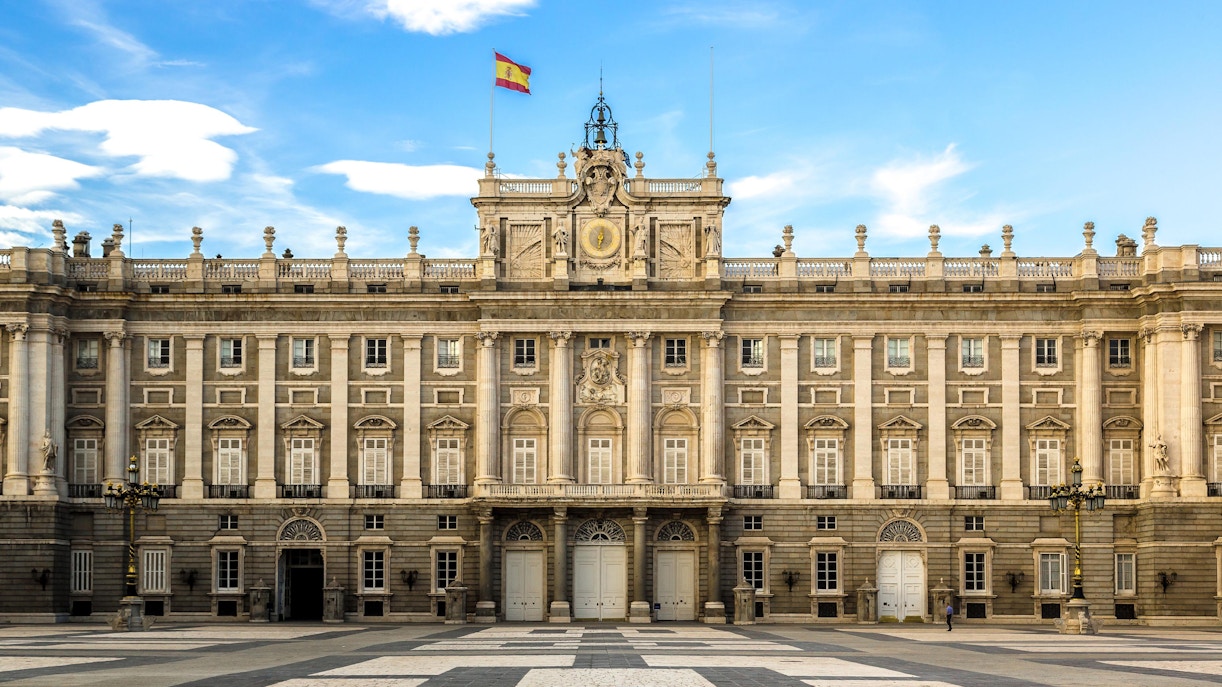- Prado Museum Tickets
- Madrid Flamenco Show Tickets
- Parque Warner Madrid
- Legends: The Home of Football
- Santiago Bernabeu Tours
- Reina Sofia Museum
- Thyssen-Bornemisza National Museum Tickets
- Parque De Atracciones De Madrid Tickets
- Madrid Zoo Aquarium
- Liria Palace
- Wax Museum Madrid
- Cívitas Metropolitano Stadium Tours
- Museum of Illusions Madrid
- Puy du Fou España
- Madrid to El Escorial tours
- Royal Palace of Aranjuez
- Royal Palace of La Granja of San Ildefonso
- Atlantis Aquarium Madrid
Royal Palace of Madrid History & Architecture | Highlights, Facts & More
About the Royal Palace of Madrid

The Royal Palace of Madrid is among the most significant attractions in the Spanish capital. The official residence of the Spanish Royal Family, the palace has a long history dating all the way back to the 9th century, with the current building completed in the 18th century.
One of the biggest palaces in Europe
The sprawling palace, among the biggest in Europe, was designed by Italian architect Filippo Juvarra and completed by his Spanish successor, Juan de Villanueva. It features 3,418 rooms and a massive art collection, including works by Spanish and European artists such as Goya, Velazquez, and Rubens.
Major cultural and historical importance
Besides its size and art exhibits, the Royal Palace of Madrid also holds cultural and historical importance. It played a critical role in Spanish history, serving as the home of the Spanish monarchy for centuries. You can tour the palace and its ground, exploring the Throne Room, the Hall of Mirrors, and the Royal Armory.
About Royal Palace of MadridRoyal Palace of Madrid history explained

Before 18th century
The Royal Palace of Madrid’s history can be broadly divided into two: pre-and post-18th century. Emir Mohamed I, the Umayyad Emir of Cordoba, chose Magerit (Madrid’s Arabic name) as the site for a fortress, called Antiguo Alcazar, translated as the Old Fortress. It was used to protect Toledo from the advancing Christians. However, it served little use for a few centuries until it became part of the city defence and the seat of the Royal Court at the end of the 15th century.

18th century and after
Antiguo Alcazar was demolished in 1734, bringing an end to the historical fortress that existed for centuries. King Philip V ordered the construction of a new palace in the same place in 1738, with Filippo Juvarra as the main architect. However, he died before construction began. Italian architect Giambattista Sacchetti took over, giving the palace a Baroque design. Francesco Sabatini joined him in 1760 to expand the building and helped complete the Royal Palace of Madrid in 1764.
Architects involved in the construction of the Royal Palace of Madrid

Filippo Juvarra
King Philip V picked Filippo Juvarra to design the Royal Palace of Madrid. Juvarra passed away before construction could begin. His notable works include the royal hunting lodge at Stupinigi, the Church of the Carmine in Turin, and the palace at Mafra for John V of Portugal.

Giambattista Sacchetti
Giambattista Sacchetti took over Juvarra’s proposals after the latter's death, giving the palace a Baroque design. Among his other works include the expansion of the garden-front of the Royal Palace of La Granja of San Ildefonso, Segovia, Spain, and San Filippo, Turin.

Francesco Sabatini
Francesco Sabatini joined Giambattista Sacchetti to expand the Royal Palace of Madrid in 1960. He also made the Casa de Campo and the neoclassical façade of San Francisco el Grande.
Architecture of Royal Palace of Madrid

Among the largest palaces in Europe, the Royal Palace of Madrid is an architectural and engineering masterpiece. It is spread over a total area of 135,000 square metres, standing like Madrid’s leader in the middle of the Spanish capital.
It boasts stunning French Baroque architecture with elements of neoclassical style. The palace’s façade features a combination of white limestone and granite, giving the palace an elegant and royal look. The symmetrical design perfectly occupies the area, with sculptures and carvings creating a brilliant visual effect.
Book Royal Palace of Madrid Tickets
Royal Palace of Madrid Today

The Royal Palace of Madrid is proof of the Spanish capital’s royal history and heritage. It served as the home of the royal family of Spain and was also used by the Moors as a fortress.
The palace is also among the largest in Europe, with a mix of several architectural styles. You can visit the palace and explore its beautiful campus and fantastic interiors, including the Royal Armoury. It houses the armour and weaponry used by the royals since the 13th century.
The other rooms you can visit include the Royal Pharmacy and Charles III’s private room, the Hall of Mirrors, and the Throne Room.
Frequently Asked Questions About the Royal Palace of Madrid’s History
The Royal Palace of Madrid was constructed in 1764, making it over two centuries old.
The Royal Palace of Madrid is famous because it was the home of the Spanish monarch.
The Royal Palace of Madrid is in western Madrid, in the heart of the Spanish capital. Find on Maps
Filippo Juvarra, Giambattista Sacchetti, and Francesco Sabatini designed the Royal Palace of Madrid.
The Royal Palace of Madrid has a Baroque architectural style with neoclassical elements.
The cost of visiting the Royal Palace of Madrid depends on your ticket type.
Yes. Guided tours explaining the Royal Palace of Madrid are available.
Yes. The Royal Palace of Madrid is worth visiting because it introduces you to the lives of the Spanish royals.



